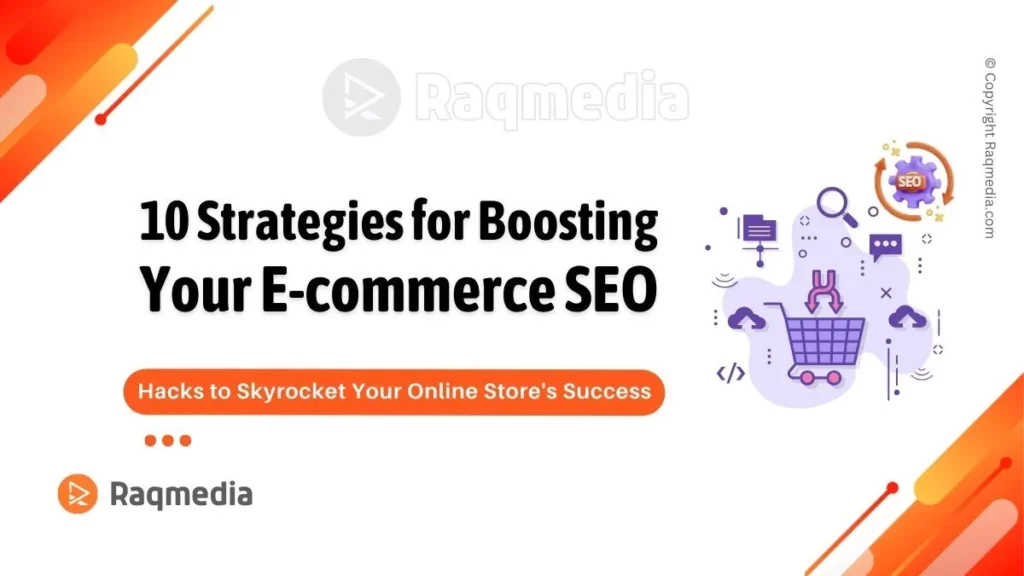Search Engine Optimization (SEO) is a crucial aspect of running an e-commerce business. It's not enough to just have a great website. If people can't find you online, your business won't succeed. With the ever-increasing competition in the e-commerce industry, it's crucial that your website ranks high in search engine results pages (SERPs). But the question is, how can you improve your e-commerce SEO performance? In this blog post, we will be sharing 10 proven strategies that will help you boost your e-commerce SEO performance.
From optimizing your product descriptions to creating a mobile-friendly website, we'll cover all the essential aspects that will help your e-commerce business thrive. So, if you're ready to take your e-commerce SEO performance to the next level, keep reading!
Table of Contents
- 1 Introduction to E-commerce SEO
- 2 Conducting keyword research
- 3 Creating high-quality, optimized product descriptions
- 4 Making sure your website is mobile-friendly and responsive
- 5 Optimizing your site structure and navigation
- 6 Creating a blog to drive traffic and build links
- 7 Building quality inbound links
- 8 Using social media to drive traffic to your site
- 9 Creating product review and comparison pages
- 10 Making use of Google Analytics to track your progress and adjust your strategy
- 11 Conclusion and final thoughts
Introduction to E-commerce SEO
In today's digital era, e-commerce is a booming industry, and with the ever-growing competition, every business owner wants their website to rank at the top of search engine results pages (SERPs). This is where E-commerce SEO comes in.

E-commerce SEO is a set of tactics and strategies that aim to improve the visibility of an e-commerce website in search engine results pages. By optimizing your website for search engines, you can reach a broader audience, drive traffic to your website, and ultimately increase your sales and revenue.
However, e-commerce SEO is not a one-time task; it is an ongoing process that requires consistent effort and dedication. It involves optimizing various aspects of your website like product listings, user experience, technical SEO, and content marketing.
In this blog post, we will discuss 10 proven strategies for boosting your e-commerce SEO performance. Whether you are a beginner or an experienced e-commerce business owner, these strategies will help you to optimize your website and rank higher in search engine results pages.
Conducting keyword research
Keyword research is an integral part of any successful e-commerce SEO strategy. It involves identifying the keywords and phrases that potential customers are using to search for the products or services you offer, and then optimizing your website to rank well for those keywords.
To conduct keyword research, start by brainstorming a list of potential keywords and phrases that you think your customers might use to find your products. You can use tools like Google's Keyword Planner or SEMrush to see how often those keywords are searched for and how competitive they are.
It's important to choose keywords that are relevant to your products and have a high search volume. But it's also important to choose keywords that are not too competitive, as it can be difficult to rank well for highly competitive keywords. Instead, focus on long-tail keywords, which are longer, more specific phrases that are less competitive but still highly relevant to your products.
Once you have identified your target keywords, you can start optimizing your website by including those keywords in your page titles, meta descriptions, header tags, and content. But be careful not to overuse keywords, as this can be seen as spammy and can actually hurt your SEO performance.
By conducting thorough keyword research and optimizing your website accordingly, you can improve your e-commerce SEO performance and attract more targeted traffic to your website.
Creating high-quality, optimized product descriptions
One of the most important aspects of your e-commerce SEO strategy is creating high-quality, optimized product descriptions. Product descriptions are the key element that tells the customer what your product is all about and why they should buy it. If your product descriptions are not well written, then your customers may lose interest and move on to your competitors.
Creating high-quality, optimized product descriptions involves using the right keywords that will help your products rank higher on search engines. This can be achieved by conducting thorough keyword research and identifying the keywords that your target audience is using. Once you have identified these keywords, you should incorporate them into your product descriptions in a natural and meaningful way.
In addition to using the right keywords, your product descriptions should be well-written, engaging, and informative. They should accurately describe your product, highlighting its features, benefits, and unique selling points. The goal is to persuade your customers to buy your product by providing them with all the information they need to make an informed decision.
Remember that your product descriptions are not only important for SEO but also for your customers. By providing them with high-quality, optimized product descriptions, you will build trust and credibility with your customers, which in turn will lead to more sales and repeat business.
Making sure your website is mobile-friendly and responsive
In today's digital age, it's no longer enough for your e-commerce website to just look good on a desktop computer. With more and more people using their smartphones and tablets to shop online, having a mobile-friendly and responsive website is essential for boosting your e-commerce SEO performance.
A mobile-friendly website is designed to provide an optimal user experience for people browsing your website on a smaller screen. This means that your website should be easy to navigate, read, and interact with on a mobile device.

On the other hand, a responsive website is designed to automatically adjust its layout and content to fit the screen size of the device the visitor is using. This means that your website will look just as good on a smartphone as it does on a desktop computer, without the need for zooming or horizontal scrolling.
Not only does having a mobile-friendly and responsive website improve the user experience, but it is also a ranking factor for search engines like Google. In fact, Google has stated that “mobile-friendliness” is now a critical factor in its search algorithm. This means that if your website is not mobile-friendly or responsive, it could be penalized in search rankings.
In summary, making sure that your e-commerce website is mobile-friendly and responsive is crucial for improving your SEO performance and ensuring that your website can be easily accessed and navigated by your customers, no matter what device they are using.
Optimizing your site structure and navigation is one of the most important steps for boosting your e-commerce SEO performance. A well-structured website allows search engines to easily crawl and index your pages, and it helps users to quickly find what they are looking for. Here are some tips for optimizing your site structure and navigation:
- 1. Use a clear and concise URL structure: Your URLs should be short, descriptive, and include relevant keywords.
- 2. Create a logical hierarchy: Organize your site into categories and subcategories, and make sure your pages are grouped together in a logical way.
- 3. Use breadcrumbs: Breadcrumbs provide a clear path for users to navigate your site, and they also help search engines understand the structure of your site.
- 4. Use internal linking: Linking to other pages on your site helps search engines understand the relationships between your pages, and it also helps users find related content.
- 5. Optimize your navigation menu: Your navigation menu should be easy to use and clearly labeled. Use descriptive labels and avoid vague or generic terms.
- 6. Use header tags: Header tags (H1, H2, H3) help search engines understand the structure of your content, and they also make your content easier to read for users.
- By optimizing your site structure and navigation, you can improve your e-commerce SEO performance and provide a better user experience for your customers.
Creating a blog to drive traffic and build links
Creating a blog is a great way to drive traffic to your e-commerce site and improve your SEO performance. By regularly creating content that is relevant to your target audience, you can position yourself as an authority in your niche and build a loyal following of readers who are interested in your products or services.

In addition to driving traffic to your site, blogging can also help you build links, which are an important factor in SEO. When other websites link to your blog posts, it signals to search engines that your content is valuable and authoritative. This can help improve your search engine rankings and drive even more traffic to your site.
When creating blog content, it's important to focus on topics that are relevant to your audience and related to your products or services. You can also use your blog to showcase your products, provide helpful tips and advice, and share industry news and trends.
Be sure to optimize your blog posts for SEO by including relevant keywords and meta descriptions, and promoting your content on social media and other channels to drive traffic and build links. By consistently creating high-quality blog content, you can improve your SEO performance and drive more traffic and sales to your e-commerce site.
Building quality inbound links
Building quality inbound links to your e-commerce site is one of the most important strategies for boosting your SEO performance. Inbound links are links from other websites that point to your site. The quality and quantity of these links are an important factor in determining your site's authority and relevance to search engines.
However, it's important to note that not all inbound links are created equal. Low-quality links from spammy or irrelevant sites can actually hurt your SEO performance. On the other hand, high-quality links from authoritative, relevant sites can have a significant impact on your rankings.
So how do you build quality inbound links to your e-commerce site? One effective strategy is to create high-quality content that other sites will want to link to. This could include blog posts, infographics, videos, or other types of content that provide value to your target audience.
Another strategy is to reach out to influencers or bloggers in your industry and ask them to link to your site. This can be done through email outreach or by building relationships on social media.
In addition, you can also look for opportunities to guest post on other sites in your industry, which can help you build relationships with other site owners and earn valuable links back to your site.
Overall, building quality inbound links is a long-term strategy that requires patience and persistence. But by focusing on creating high-quality content and building relationships with other sites in your industry, you can improve your SEO performance and drive more traffic to your e-commerce site.
Social media is a great platform for businesses to reach out to potential customers and promote their products or services. The power of social media is immense and can be leveraged to drive traffic to your e-commerce site.
It's important to have a strong social media presence with active and engaging accounts on all the major platforms such as Facebook, Twitter, Instagram, and LinkedIn. Post regularly about your products, promotions, and other important updates to keep your followers engaged and interested.
Use social media to run campaigns and promotions that encourage your followers to visit your site. You can also use social media to generate user-generated content such as product reviews and unboxing videos, which can be shared on your website and social media channels to attract more traffic.
You can also use social media to collaborate with influencers and bloggers in your niche. These collaborations can help you reach a wider audience and drive more traffic to your site. Influencers can promote your products to their followers, and you can also offer discounts and promotions to their followers to attract more traffic.
In addition to social media, you can also use other online marketing channels such as email marketing, PPC advertising, and content marketing to drive traffic to your e-commerce site. By using these channels effectively, you can improve your e-commerce SEO performance and attract more customers to your online store.
Creating product review and comparison pages
Creating product review and comparison pages is a great SEO strategy that can help you improve your e-commerce site's performance. These pages not only provide valuable information for potential customers, but they also help to increase the amount of content on your site, which can improve your search engine rankings.

When creating product review and comparison pages, it's important to keep in mind that the content should be high quality, informative, and unbiased. This will help to build trust with your audience and make them more likely to make a purchase.
One effective approach is to create a comparison table that lists the features and benefits of each product side-by-side. This makes it easy for customers to compare the products and make an informed decision.
Additionally, including customer reviews on these pages can further improve their value. Not only do customer reviews provide social proof, but they also provide unique content that can help to improve your search engine rankings.
When creating product review and comparison pages, it's also important to optimize them for SEO. This means including relevant keywords in the title, headings, and throughout the content. Additionally, including internal links to these pages from other relevant pages on your site can help to improve their visibility to search engines.
Making use of Google Analytics to track your progress and adjust your strategy
One of the most important steps in boosting your e-commerce SEO performance is to track your progress and adjust your strategy accordingly. This is where Google Analytics comes in handy.
Google Analytics is a powerful tool that provides you with a wealth of data about your website's performance.
By tracking metrics such as bounce rate, time on site, and conversion rate, you can gain valuable insights into how visitors are interacting with your site and where you need to make improvements.
For example, if you notice a high bounce rate on a particular page, you may need to optimize the content or improve the user experience to keep visitors engaged and on your site for a longer period of time.
Google Analytics also allows you to track the performance of your SEO efforts. By setting up goals and tracking conversions, you can see how your SEO campaigns are impacting your bottom line and make adjustments accordingly.
In addition to tracking your progress, Google Analytics can also help you identify new opportunities for growth. By analyzing search data and identifying keywords that are bringing in traffic, you can optimize your content and target new keywords to attract even more visitors to your site.
Overall, making use of Google Analytics is essential for any e-commerce store looking to improve their SEO performance and drive more traffic to their site. By carefully tracking your progress and making adjustments based on the data, you can stay ahead of the competition and continue to grow your business.
Conclusion and final thoughts
In conclusion, boosting your e-commerce SEO performance is vital for success in today's digital world. With so many businesses competing for online visibility, it's important to stay ahead of the curve and implement the latest SEO strategies.
From conducting thorough keyword research to optimizing your website for mobile devices, there are many proven strategies that can help improve your SEO performance and drive more traffic to your e-commerce store.
It's also important to keep in mind that SEO is an ongoing process and requires continuous effort to maintain and improve your rankings. By regularly monitoring your website's performance, analyzing your competitors, and keeping up with the latest industry trends, you can stay ahead of the game and ensure long-term success.
Remember, SEO is not a magic solution that will instantly boost your sales, but it is a crucial part of any successful e-commerce strategy. By implementing these proven strategies and staying committed to your SEO efforts, you can achieve greater visibility, drive more traffic, and ultimately increase sales for your online store.
We hope you found our guide to boosting your e-commerce SEO performance helpful. With the strategies we've provided, you should be able to improve your online visibility, attract more traffic to your website, and ultimately increase your sales.
Keep in mind that SEO is an ongoing process, so it's important to continuously monitor and update your strategies to stay ahead of the competition. Best of luck with your e-commerce store, and we look forward to seeing your online success!








Boost your e-commerce game with these 🔟 proven SEO strategies! 🚀 From keyword research to mobile-friendly websites, Raqmedia has your back. 🌐💼 Check out the full guide here:
.
https://www.raqmedia.com/strategies-for-boosting-your-e-commerce-seo/
.
#raqmedia #SEOtips #EcommerceSuccess #DigitalMarketing #OnlineVisibility #SEOstrategy #WebTraffic #RaqmediaGuide